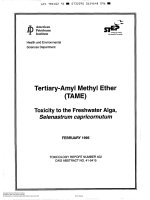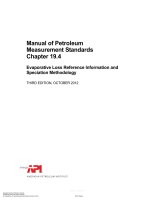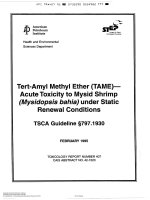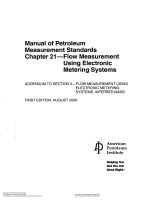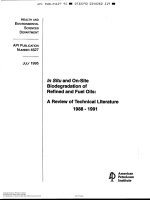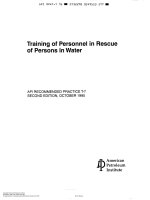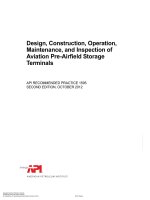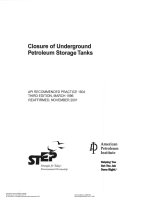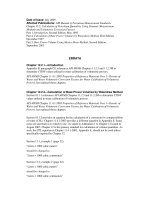Api mpms 2 2a 1995 (2012) (american petroleum institute)
Bạn đang xem bản rút gọn của tài liệu. Xem và tải ngay bản đầy đủ của tài liệu tại đây (3.05 MB, 72 trang )
Manual of Petroleum
Measurement Standards
Chapter 2—Tank Calibration
Section 2A—Measurement and Calibration of
Upright Cylindrical Tanks by the
Manual Tank Strapping Method
FIRST EDITION, FEBRUARY 1995
REAFFIRMED, FEBRUARY 2012
--`,,```,,,,````-`-`,,`,,`,`,,`---
Copyright American Petroleum Institute
Provided by IHS under license with API
No reproduction or networking permitted without license from IHS
Not for Resale
--`,,```,,,,````-`-`,,`,,`,`,,`---
Copyright American Petroleum Institute
Provided by IHS under license with API
No reproduction or networking permitted without license from IHS
Not for Resale
Manual of Petroleum
Measurement Standards
Chapter 2—Tank Calibration
Section 2A—Measurement and Calibration of
Upright Cylindrical Tanks by the
Manual Tank Strapping Method
Measurement Coordination
FIRST EDITION, FEBRUARY 1995
--`,,```,,,,````-`-`,,`,,`,`,,`---
REAFFIRMED, FEBRUARY 2012
Copyright American Petroleum Institute
Provided by IHS under license with API
No reproduction or networking permitted without license from IHS
Not for Resale
SPECIAL NOTES
1. API PUBLICATIONS NECESSARILY ADDRESS PROBLEMS OF A GENERAL
NATURE. WITH RESPECT TO PARTICULAR CIRCUMSTANCES, LOCAL, STATE,
AND FEDERAL LAWS AND REGULATIONS SHOULD BE REVIEWED.
2. API IS NOT UNDERTAKING TO MEET THE DUTIES OF EMPLOYERS, MANUFACTURERS, OR SUPPLIERS TO WARN OR PROPERLY TRAIN AND EQUIP
THEIR EMPLOYEES, AND OTHERS EXPOSED, CONCERNING HEALTH AND
SAFETY RISKS AND PRECAUTIONS, NOR UNDERTAKING THEIR OBLIGATIONS
UNDER LOCAL, STATE, OR FEDERAL LAWS.
3. INFORMATION CONCERNING SAFETY AND HEALTH RISKS AND PROPER
PRECAUTIONS WITH RESPECT TO PARTICULAR MATERIALS AND CONDITIONS SHOULD BE OBTAINED FROM THE EMPLOYER, THE MANUFACTURER
OR SUPPLIER OF THAT MATERIAL, OR THE MATERIAL SAFETY DATA SHEET.
5. GENERALLY, API STANDARDS ARE REVIEWED AND REVISED, REAFFIRMED, OR WITHDRAWN AT LEAST EVERY FIVE YEARS. SOMETIMES A
ONE-TIME EXTENSION OF UP TO TWO YEARS WILL BE ADDED TO THIS
REVIEW CYCLE. THIS PUBLICATION WILL NO LONGER BE IN EFFECT FIVE
YEARS AFTER ITS PUBLICATION DATE AS AN OPERATIVE API STANDARD, OR
WHERE AN EXTENSION HAS BEEN GRANTED, UPON REPUBLICATION.
STATUS OF THE PUBLICATION CAN BE ASCERTAINED FROM THE API
AUTHORING DEPARTMENT [TELEPHONE (202) 682-8000]. A CATALOG OF API
PUBLICATIONS AND MATERIALS IS PUBLISHED ANNUALLY AND UPDATED
QUARTERLY BY API, 1220 L STREET, N.W., WASHINGTON, DC 20005.
Copyright © 1995 American Petroleum Institute
Copyright American Petroleum Institute
Provided by IHS under license with API
No reproduction or networking permitted without license from IHS
Not for Resale
--`,,```,,,,````-`-`,,`,,`,`,,`---
4. NOTHING CONTAINED IN ANY API PUBLICATION IS TO BE CONSTRUED AS
GRANTING ANY RIGHT, BY IMPLICATION OR OTHERWISE, FOR THE MANUFACTURE, SALE, OR USE OF ANY METHOD, APPARATUS, OR PRODUCT
COVERED BY LETTERS PATENT. NEITHER SHOULD ANYTHING CONTAINED
IN THE PUBLICATION BE CONSTRUED AS INSURING ANYONE AGAINST
LIABILITY FOR INFRINGEMENT OF LETTERS PATENT.
API publications may be used by anyone desiring to do so. Every effort has been made
by the Institute to assure the accuracy and reliability of the data contained in them; however,
the Institute makes no representation, warranty, or guarantee in connection with this publication and hereby expressly disclaims any liability or responsibility for loss or damage
resulting from its use or for the violation of any federal, state, or municipal regulation with
which this publication may conflict.
Suggested revisions are invited and should be submitted to Measurement Coordination,
Exploration and Production Department, American Petroleum Institute, 1220 L Street,
N.W., Washington, D.C. 20005.
iii
Copyright American Petroleum Institute
Provided by IHS under license with API
No reproduction or networking permitted without license from IHS
Not for Resale
--`,,```,,,,````-`-`,,`,,`,`,,`---
FOREWORD
--`,,```,,,,````-`-`,,`,,`,`,,`---
Copyright American Petroleum Institute
Provided by IHS under license with API
No reproduction or networking permitted without license from IHS
Not for Resale
CONTENTS
SECTION 2A-MEASUREMENT AND CALIBRATION OF UPRIGHT
CYLINDRICAL TANKS BY THE MANUAL TANK
STRAPPING METHOD
Page
--`,,```,,,,````-`-`,,`,,`,`,,`---
2.2A.I Scope
1
2.2A.2 Referenced Publications
1
2.2A.3 Safety.....
1
2.2A.4 Definitions
2
2.2A.5 Significance
2
2.2A.6 Equipment......................................................................................................... 2
2.2A.6.I Tapes for Height Measurement.............................
2
2.2A.6.2 Tapes for Circumference Measurement..
3
2.2A.6.3 Accessory Equipment
3
4
2.2A.7 Calibration of Working Tape with the Master Tape
2.2A.8 General Practices..........................................
5
2.2A.9 Tank Status Before Calibration
5
2.2A.IO Descriptive Data...............................
5
2.2A.II Tolerances.........................................
5
2.2A.I2 Shell Plate Thicknesses
5
10
2.2A.I3 Vertical Tank Measurements......
2.2A.I4 Circumferential Measurements
12
2.2A.14.I Preparation
12
2.2A.14.2 Physical Measurements
13
2.2A.I5 Deadwood Measurement
15
2.2A.I6 Tank Bottoms
18
2.2A.17 Floating Roofs
18
2.2A.I7.1 General
18
2.2A.17.2 Floating Roof Weight
18
2.2A.I7.3 Deadwood Determination....................................................................
18
2.2A.17,4 Deducting Floating Roof Displacement
18
2.2A.18 Insulated Tanks
18
2.2A.19 Tank Capacity Table Development: Calculation Procedures....
21
2.2A.19.1 Capacity Table Requirements
22
2.2A.19.2 Calibration of the Master Tape to 60°F
22
2.2A.19.3 Conversion of Outside to Inside Circumferences
22
2.2A.19,4 Deductions for Circumference Tape Rises
22
2.2A.19.5 Expansion and Contraction of Steel Tank Shells Due to Liquid Head
25
2.2A.19.6 Expansion and Contraction of Steel Tank Shells Due to Temperature
27
2.2A.19.7 Effect of Tilt on Cylindrical Portion of Tank.
27
2.2A.19.8 Floating Roofs
28
2.2A.19.8.1 Liquid Calibration for Floating Roof Displacement
28
2.2A.19.8.2 Measurement Procedure for Floating Roof Displacement
28
2.2A.19.8.3 Liquid Level Above Position B
28
2.2A.l9.8,4 Capacity Table With Floating Roof Treated as Deadwood
29
2.2A.19.8.5 Capacity Table of Gross or Open-Tank Capacity............................. 29
2.2A.19.9 Summary Data on the Capacity Table
30
30
2.2A.19.10 Recalibration Requirements ~
30
2.2A.19.11 Certification of Capacity Tables
APPENDIX A- GUIDELINES FOR RECALIBRATION OF
STORAGE TANKS........................................................................... 31
v
Copyright American Petroleum Institute
Provided by IHS under license with API
No reproduction or networking permitted without license from IHS
Not for Resale
Page
Figures
I-Height Measuring Tape and Bob
2-Strapping Tapes for Circumference Measurements........
3-Jointed Type Tape Guides
4--Record Form for Deadwood..............................
5-Measurement Locations for Welded Upright Tanks
6--Measurement Locations for Riveted Shingled Arrangement..
7-Measurement Locations for Bolted Tanks............................................................
8-Vertical Tank Measurements-Welded
9-Vertical Tank Measurements-Bolted
10-Vertical Tank Measurements-Riveted
II-Effective Inside Tank Height-Cone Roof
I2-Effective Inside Tank Height-Floating Roof
13-Spherical Segment (Dished), Hemispherical and Semi-Ellipsoidal
Bottoms, Convex and Accessible Measurements of Upright Tanks...................
14--Coned Downward Bottom and Accessible Measurements of Upright Tanks
I5-Diagram of Floating Roof at Rest (A) and Floating (B)
I6--Typical Steel Pontoon Floating Roof With Single Center Deck
17-True Circumference Versus Tape Path at Axial Lap Joint Away
From Circumferential Joint
B-I-Upright Cylindrical Tanks Composite Construction
B-2-Typical NIST Report of Calibration
E-I-Locations of Measurements on Upright Cylindrical Concrete
Underground Tanks
E-2-Locations of Measurements on Rectangular Steel or Concrete
Underground Tanks
F-I-External Floating-Roof Tank Decision Chart
F-2-Fixed-RoofTank Decision Chart
F-3-Chart for Internal Floating-Roof Tanks
Tables
I-Suggested Record Form "A" for Measurements of Upright
Cylindrical Tanks................
2-Suggested Record Form "B" for Measurements of Upright
Cylindrical Tanks........................
3-Elevations for Circumference Measurements on Various Types of
Upright Cylindrical Tanks
4--Circumferential Tolerances..
5-Customary Version Capacity Table
6--SI Version Capacity Table
A-I-Tank Bottom Course Inside Diameter Variations......
A-2-Tank Bottom Course Plate Thickness
A-3-Volume Correction for Table Tilt..
A-4--Tank Shell Temperature Variations
A-5-Product Specific Gravity Variations
vi
Copyright American Petroleum Institute
Provided by IHS under license with API
No reproduction or networking permitted without license from IHS
Not for Resale
35
47
49
53
57
2
3
4
6
9
10
11
12
14
15
16
17
19
20
21
25
26
35
36
54
55
58
58
58
7
8
13
13
23
24
31
31
31
31
32
--`,,```,,,,````-`-`,,`,,`,`,,`---
APPENDIX B- EXAMPLE CALCULATIONS FOR UPRIGHT
CYLINDRICAL STEEL TANK-ABOVEGROUND
APPENDIX C- GUIDELINES FOR COMPUTER INPUT
APPENDIX D- SHELL TEMPERATURE CORRECTION FACTORS
APPENDIX E- UNDERGROUND TANKS
APPENDIX F- TANK CALIBRATION METHOD SELECTION
Page
B-I-Typical Measurement Record of an Upright Cylindrical Steel
Tank for Example Calculations
B-2-Typical NIST Report of Calibration
B-3A-Tank Table Run Sheet
:;
B-3B-Run Sheet for Soft Conversion to Metric
--`,,```,,,,````-`-`,,`,,`,`,,`---
vii
Copyright American Petroleum Institute
Provided by IHS under license with API
No reproduction or networking permitted without license from IHS
Not for Resale
37
38
44
45
1
1
1
1
1
1
1
1
1
1
1
1
1
1
1
1
1
1
1
1
1
1
1
--`,,```,,,,````-`-`,,`,,`,`,,`---
1
1
1
1
1
1
1
1
1
1
1
1
1
1
1
1
1
1
1
1
1
1
1
1
1
1
1
1
1
1
1
1
1
1
1
1
1
1
1
1
1
1
1
1
1
1
1
I
Copyright American Petroleum Institute
Provided by IHS under license with API
No reproduction or networking permitted without license from IHS
Not for Resale
Chapter 2-Tank Calibration
SECTION 2A-MEASUREMENT AND CALIBRATION OF
UPRIGHT CYLINDRICAL TANKS BY THE MANUAL TANK STRAPPING METHOD
2.2A.1
Scope
2.2A.1.1 This standard describes the procedures for calibrating upright cylindrical tanks used primarily for the
storage of petroleum liquids. Section 2A first addresses
procedures for making necessary measurements to determine
total and incremental tank volumes and then presents the
recommended procedures for computing volumes.
2.2A.1.2 Both SI (metric) and customary units are
presented where appropriate in the chapter. SI and customary
conversions may not necessarily be exact. The SI units often
reflect what is available in commercial equipment.
2.2A.1.3 The standard also provides guidelines for recalibration and for computerization of capacity tables.
2.2A.2 References
2.2A.2.1
REFERENCED PUBLICATIONS
2.2A.2.2
The following publications are listed for information only:
API
Std 2551
Measurement and Calibration of Horizontal
Tanks
Std 2552 Measurement and Calibration ofSpheres and
Spheroids
Std 2554 Measurement and Calibration of Tank Cars
Manual ofPetroleum Measurement Standards
Chapter 2, "Tank Calibration," Section 7,
"Calibration of Barge Tanks;" Section 8A,
"Calibration of Tanks on Ships and Oceangoing Barges"
IS0 7
7507-1
The following publications are cited in this standard:
7507-2
API
Welded Steel Tanks for Oil Storage
Tank Inspection, Repair, Alteration, and
Reconstruction
Std 2555 Liquid Calibration ofTanks
Manual ofPetroleum Measurement Standards
Chapter 2, "Tank Calibration," Section 2B,
"Calibration of Upright Cylindrical Tanks
Using the Optical Reference Line Method"
Std 650
Std 653
ICS1/0CIMF2/IAPH 3
International Safety Guide for Oil Tankers and Terminals
(ISGOrrt
--`,,```,,,,````-`-`,,`,,`,`,,`---
Ip5
Petroleum Measurement Manual
Part 2, "Tank Calibration," Section 1, "Vertical
Cylindrical Tanks, Measurement Methods"
NFPA6
306
Control of Gas Hazards on Vessels
I International Chamber of Shipping, 30/32 Mary Axe Street, London EC3A
8ET, England.
20il Companies International Marine Forum, Portland House, 6th Floor,
Stag Place, London SWIE 5BH, England.
3Intemational Association of Ports and Harbors, Kotohira-Kaikan Building,
2-8, Toranomon l-Chome Minato-Ku, Tokyo 105, Japan.
4/SGOIT is available from Witherby & Co., Ltd. (Marine Publishing), 32/36
Aylesbury Street, London EC IR OET, England.
SIP, 61 New Cavendish Street, London WIM 8AR, England.
6National Fire Protection Association, I Batterymarch Park, PO. Box 9101,
Quincy, Massachusetts 02269-910 I.
Copyright American Petroleum Institute
Provided by IHS under license with API
No reproduction or networking permitted without license from IHS
INFORMATIVE PUBLICATIONS
7507-3
Petroleum and Liquid Petroleum Products:
Volumetric Calibration of Vertical Cylindrical Tanks, Part 1, "Strapping Method"
Petroleum and Liquid Petroleum Products:
Volumetric Calibration of Vertical Cylindrical Tanks, Part 2, "Optical Reference Line
Method"
Petroleum and Liquid Petroleum Products:
Volumetric Calibration of Vertical Cylindrical Tanks Part 3, "Optical Triangulation
Method"
J
2.2A.3
Safety
2.2A.3.1 Before entering any tank, permission must be
obtained from the Terminal Supervisor, authorized official,
or other responsible person in charge. This responsible
person should supply information regarding particular materials and conditions or the applicable Material Safety Data
Sheet (MSDS).
2.2A.3.2 Due consideration should be given to applicable
safety procedures. Safety considerations include, but are not
limited to, potential electrostatic hazards, potential personnel
exposure (and associated protective clothing and equipment
requirements), and potential explosive and toxic hazards
associated with a storage tank's atmosphere. The physical
characteristics of the product and existing operational conditions should be evaluated, and applicable international,
federal, state, and local regulations should be observed.
7Intemational Organization for Standardization. ISO publications are available from ANSI.
Not for Resale
CHAPTER
2.2A.3.3 In addition, before entering a storage tank,
safety procedures designated by the employer, the terminal
operator, and all other concerned parties should also be
observed. It shall be indicated that the tank is "Safe for
Workers" and/or "Safe for Hot Work," as prescribed in
NFPA 306, U.S. Coast Guard, OSHA, or other international,
federal, state, or local regulations that may apply. Such
testing must be made at least every 24 hours or more
frequently when conditions warrant.
2.2A.3.4 Internationally, the International Safety Guide
for Oil Tankers And Terminals (ISGOTT) should be
consulted.
2,
SECTION
2A
2.2A.5
Significance
2.2A.5.1 Accurate tank circumference measurements are
critical in determinations of liquid volume and the development of capacity table for Custody Transfer transactions and
inventory control. This standard provides measurement and
computational procedures for the development of such a
capacity table.
2.2A.5.2 All such measurements should be witnessed by
all parties involved to ensure compliance with the procedure
outlined in the standard and overall measurement integrity.
2.2A.6
Equipment
2.2A.3.5 Furthermore, another person should stand watch
at the tank entrance for the duration, and sound an alarm if
an emergency occurs. Appropriate protective clothing and
equipment should be used. Normal safety precautions with
respect to staging and ladders must also be observed.
The equipment used in dimensional Tank Calibration is
described in 2.2A.6.1 through 2.2A.6.3. All equipment shall
be in good working condition. All tapes shall be in one piece
and free of kinks.
2.2A.4
2.2A.6.1
Definitions
2.2A.4.1 A Capacity Table or a Tank Capacity Table
shows the capacities of, or volumes in a tank for various
liquid levels measured from the reference gauge point.
2.2A.4.2 Deadwood refers to any object within the tank,
including a floating roof, which displaces liquid and reduces
the capacity of the tank; also any permanent appurtenances
on the outside of the tank, such as cleanout boxes or
manholes, which increase the capacity of the tank.
TAPES FOR HEIGHT MEASUREMENT
For height measurements, a steel tape (see Figure 1), of
convenient length, Ys or Y2 inches wide and 0.008 to 0.012
inches thick, graduated in feet and inches to eights of an
inch, or in feet, tenths, and hundredths of a foot is recommended. (For metric tapes, refer to IP Petroleum Measurement Manual, Part 2, Section 1) Graduations shall be
2.2A.4.3 False Bottom is commonly referring to a new
bottom installed on top of the previous tank bottom, which
will reduce the bottom ring height and the effective inside
tank height.
2.2A.4.4 Master Tape is a tape that is used for calibrating
working tapes for tank measurement and is identified with a
Report of Calibration at 68 degrees Fahrenheit (68°F) [20
degrees Celsius (20°C)] and at a specific tension designated
by the National Institute of Standards and Technology
(NIST) or an equivalent international standard organization.
2.2A.4.5 Tank Strapping is the term commonly applied to
the procedure for measuring tanks to provide the dimensions
necessary for computing capacity tables that will reflect the
quantity of product in a tank at any given depth/level.
2.2A.4.6 Reference Gauge Height is the vertical distance
between the reference point on the gauge hatch and the
striking point on the tank floor or on the gauge datum plate.
2.2A.4.7 Successive Tangent Method is the measurement
of a circumference on a tank when the tape is not long
enough to span the entire circumference of a tank.
2.2A.4.8 Continuous Wraparound Procedure is the
measurement of a tank circumference with a tape that is long
enough to span the entire circumference of a tank.
Copyright American Petroleum Institute
Provided by IHS under license with API
No reproduction or networking permitted without license from IHS
Figure 1-Height Measuring Tape and Bob
Not for Resale
--`,,```,,,,````-`-`,,`,,`,`,,`---
2
MEASUREMENT AND CALIBRATION OF UPRIGHT CYLINDRICAL TANKS
accurate within 1i'6 inch or 0.005 foot (or to nearest
millimeter) throughout that portion of the tape to be used.
2.2A.6.2
TAPES FOR CIRCUMFERENCE
MEASUREMENT
For circumference measurements, a mild steel tape, (see
Figure 2) of convenient length relative to the tank circumference is recommended. The working tape is usually 100,200,
300, or 500 feet long and should not be more than X inch
wide, and approximately 0.01 inch thick. The tape may be
graduated in feet, with an extra 1 foot length at the zero end
of the tape and graduated in tenths and hundredths of a foot,
or it may be graduated in feet, tenths and hundredths of a
foot throughout its length (for metric tapes, refer to IP
Petroleum Measurement Manual, Part 2, Section 1). All
working tapes should be calibrated with a Master tape (refer
to 2.2A.7).
2.2A.6.3
ACCESSORY EQUIPMENT
Additional measuring equipment recommended is listed
below. Other similar equipment may be used, provided it
will give the same results.
a. Reels and tapes shall be equipped with appropriate reels
and handles.
b. Tape clamps: for assurance of positive grip on tape,
clamps shall be used.
c. A spring tension scale is needed.
d. Rope and ring: two lengths of rope line fitted with snap
and ring are to be used in raising and lowering circumference
measurement tape. Alternatively, jointed-type pole guides
may be used (see Figure 3).
e. Transit or level or both are used when required.
f. Ladders to facilitate handling of tapes and removal of scale,
rust, dirt, etc. from the path of measurement are needed.
g. An ultrasonic thickness measurement device is used.
h. A plumb line is needed.
i. Depth Gauge: a depth gage of case-hardened steel, 6
inches in length, graduated to Y64 inch (1 millimeter resolution and read to nearest 0.5 millimeter) is for determination
of thickness of steel plates is needed.
j. Straightedge: a straightedge of appropriate length and a
profile board for measuring knuckles are used.
k. Calipers and special clamps for spanning obstructions in
making circumference measurements, the following are
recommended:
-
Figure 2-Strapping Tapes for Circumference Measurements
--`,,```,,,,````-`-`,,`,,`,`,,`---
Copyright American Petroleum Institute
Provided by IHS under license with API
No reproduction or networking permitted without license from IHS
3
Not for Resale
4
CHAPTER
2, SECTION 2A
written on the tank shell and recorded. This procedure is
repeated until the entire circumference is measured.
c. Total the measurements obtained.
d. Place the working tape around the tank, using the same
tape path, by the continuous "wraparound" procedure.
e. Slide the working tape to break frictional resistance, and
apply tension sufficient to equal the measurement obtained
with the master tape.
f. The amount of tension, in pounds, required to be pulled on
the working tape to obtain the same measurement as that
recorded with the master tape shall be applied to the working
tape when taking circumferential measurements. If the tension
determined to be proper for the working tape is insufficient to
hold the tape in the proper position, additional tension should
be applied and a correction made to bring the reading into
agreement with that obtained with the master tape.
Figure 3-Jointed Type Tape Guides
1. Maximum 'expansion calipers of 6 inches (or 15
centimeters) for spanning the smaller obstructions, such as
vertical flanges, bolt heads, etc.
2. Maximum expansion calipers of 18 inches (45
centimeters) or 24 inches (61 centimeters) for spanning
the larger obstructions, such as butt straps, etc.
3. Special clamps may be substituted for calipers in
measuring projecting flanges.
The following may be useful equipment: a six foot ruler
for general measurements, shovel, spirit level, awl and
scriber, marking crayon, record paper, and cleaning instruments, such as a putty knife and a hard bristle brush for eliminating dirt, grease, paint scale, rust particles, etc. from the
path of circumference measurements.
2.2A.7
Calibration of Working Tape with
the Master Tape
2.2A.7.1 The tape used for circumference measurements
shall be calibrated (for required tension) by matching it
against the master tape in the following manner:
a. Choose a convenient tape path (i.e. 20 percent of ring height)
on the lower ring, and place the master tape around the tank.
b. Using the successive tangent method, make a scribe mark
on the shell, determining the origin of the circumference.
Apply the tape, with constant application of tension at which
the master tape was certified to be accurate, to the tank shell
at the proper tape path with the tape's zero mark located
exactly on the scribe mark designating the origin point. The
tape is placed in position with required tension, and the last
reading on the tape is scribed on the tank shell at each 100
feet (or 30 meters) or fraction thereof. This measurement is
2.2A.7.2 The preceding procedure shall be carried out
when calibrating other tanks whose circumference differs by
more than 20 percent from the calibrated tape section and
where tank surfaces are different.
2.2A.7.3 Two working tape corrections are illustrated in
the following examples. Note that conditions one and two for
application of working tape corrections apply for either case,
that is, where the master tape and working tape are of equal
or different lengths. The same procedure applies for metric
measurements.
a. Condition No.1: If additional tension is required to be
applied to the working tape to equal the measurement
obtained by the master tape, then no mathematical correction
is needed. The additional tension required to equal the
master tape measurement must be applied to all subsequent
circumferences obtained with the working tape.
b. Condition No.2: If the same or additional tension is
applied to both the master tape and the working tape and the
measurements do not agree, then a mathematical correction
shall be applied as indicated in the examples below. The
determined differences must be applied to all working tape
circumferences before the processing of the capacity table.
c. Examples
Example 1:
314.515 feet
Master tape at 10 pounds tension per
100 feet or part thereof.
314.475 feet
Working tape at 20 pounds tension.
0.040 feet
Example 2:
314.515 feet
314.590 feet
0.075 feet
Master tape at 10 pounds tension per
100 feet or part thereof.
Working tape at 20 pounds tension.
Correction for working tape to be
subtracted from each circumference
measured.
--`,,```,,,,````-`-`,,`,,`,`,,`---
Copyright American Petroleum Institute
Provided by IHS under license with API
No reproduction or networking permitted without license from IHS
Correction for working tape to be added
to each circumference measured.
Not for Resale
MEASUREMENT AND CALIBRATION OF UPRIGHT CYLINDRICAL TANKS
2.2A.8
General Practices
All measurements and descriptive data taken at the tank site
should be checked and immediately, legibly recorded with the
recording preferably assigned to a single individual, as follows:
a. All measurements should be taken without disruption and
preferably on the same day of calibration with the liquid
level remaining static. If measurements have to be disrupted,
interrupted tank measurement work may be continued at a
later date, without repeating the work previously completed,
provided all records of the work are complete and legible.
Movement of liquid into or out of the tank may be tolerated,
provided a clearly marked liquid gauge and average temperatures of both liquid and outside atmosphere are included as
parts of these subsequent strapping operations.
b. All data and procedures necessary for the preparation of
capacity tables should be supported by sound engineering
principles.
c. Each tank shall be identified clearly and legibly by
number or by some other suitable marking, but this identification should not be painted on tank attachments.
2.2A.9
Tank Status Before Calibration
2.2A.9.1 Before calibration, the tank shall have been
filled at least once at its present location with liquid at least
as dense as is expected to contain. The hydrostatic test (for a
period of approximately 24 hours) will usually satisfy this
requirement. Any hydrostatic test should be performed in
accordance with applicable construction and operating standards (API Standard 650 and 653). When possible, the liquid
in the tank should be allowed to stand still for approximately
24 hours before calibration is performed.
2.2A.9.2 Tanks with a nominal capacity of 500 barrels or
less may be strapped at any condition of fill, provided the
tanks have been filled at least once at their present location.
Small movements of oil into or out of such tanks are allowed
during strapping.
2.2A.9.3 Tanks with a nominal capacity of more than 500
barrels should be handled this way:
5
2.2A.10.2 The API gravity and the temperature of the
tank's contents at the time of strapping shall be obtained and
recorded. The average API gravity, average overall ambient
temperature at which the tank shall operate and maximum
safe fill height (refer to 2.2A.13.5) shall be obtained from the
tank owner and recorded.
2.2A.10.3 Supplemental sketches or notations, each
completely identified, dated, and signed, should accompany
the strapping report. These should indicate the following:
a. Typical horizontal and vertical joints.
b. Number of plates per ring.
c. Location of rings at which thickness of plates change
arrangement.
d. Size of angles at top and bottom of shell.
e. Location and size of pipes and manways.
f. Dents and bulges in shell plates.
g. Amount of lean from vertical in relation to the reference
gauge point.
h. Procedure used in bypassing a large obstruction, such as a
cleanout box or insulation box located in the path of a
circumferential measurement.
i. Location of tape path different from that shown in Figures
5 through 7.
j. Location and elevation of a possible datum plate.
k. All other items of interest and value which will be encountered.
2.2A.10.4 Entries of data on a tank measurements record
form or supplemental data sheets should not be erased. If
alteration is necessary, the entry to be changed should be
marked out with a single line and the new data recorded
adjacent to the old entry.
2.2A.11
Tolerances
2.2A.11.1 Single circumferential measurements should
be read and recorded to the nearest 0.005 feet (or nearest
millimeter), which is equal to one-half of the distance
between two adjacent hundredth-foot division marks on the
tape. Therefore, all circumferential measurements should be
recorded through the third decimal place.
a. Bolted Tanks (usually in Production Service) must have
been filled at least once at their present location and must be
at least two-thirds full when strapped. Small movements of
oil into or out of such tanks are allowed during strapping.
b. Riveted Tanks and/or Welded Tanks must have been filled
at least once at their present location. They may be strapped
at any condition of fill and the full capacity computed as
shown in 2.2A.19.5. No movement of oil into or out of such
tanks is allowed during the strapping operation.
2.2A.11.3 Thermometers should be read to the nearest
1°F (or 0.5°C).
2.2A.10
2.2A.11.5 Deadwood should be determined and located by
measurement readings to the nearest ~ inch (or 3 millimeter).
Descriptive Data
2.2A.10.1 Complete descriptive data should be entered on
the Tank Measurements Record Form being used. Suggested
record forms are shown in Figure 4 and Tables 1 and 2.
2.2A.11.2 Vertical tank measurements should be read and
recorded to the nearest 11'6 inch (or nearest 1 millimeter).
2.2A.11.4 Tank plate thicknesses should be determined to
the nearest Y64 inch (1 millimeter resolution and read to
nearest 0.5 millimeter).
2.2A.12
Shell Plate Thickness
2.2A.12.1
Plate thickness should be measured by Ultra-
--`,,```,,,,````-`-`,,`,,`,`,,`---
Copyright American Petroleum Institute
Provided by IHS under license with API
No reproduction or networking permitted without license from IHS
Not for Resale
6
CHAPTER
2,
SECTION
2A
TANK NO.
FROM
TO
PIECES
H1
H2
1.
DESCRIPTION
NOZZLE
--`,,```,,,,````-`-`,,`,,`,`,,`---
II'-
Nozzle
X
~Il
N
:r:
I
~
6"
t:.
0
0:
!:=-
,
I
">
Figure 4-Record Form for Deadwood
Copyright American Petroleum Institute
Provided by IHS under license with API
No reproduction or networking permitted without license from IHS
Not for Resale
7
WASTE MANAGEMENT PRACTICES FOR PETROLEUM MARKETING FACILITIES
Table 1-Suggested Record Form "A" for Measurements of
Upright Cylindrical Tanks
.
.
.
.
.
.
.
.
.
.
.
.
.
Tank No:
(Old Tank No.):
Owner's Name:
Plant or Property Name:
Location: ., . '"
,
Manufactured by:
Erected by:
Prepare:
Copies:
Increments in.:
Fractions to:
Table Form or Size Desired:
Height: Shell:
Gauging:
Weight of Floating Roof:
Type of Roof:
Avg. Liquid Temp., of:
_
.
Tank Contents-Name:
Gauge:
ft
in.; Innage to: Shell Floor or Outage
of Sample TemperaHydrometer Reading:
at
ture
Gauging Reference Point to Top of Top Angle:
ft.
in.; Normal Service
.
Shell Circumferences:
A
.
G
..
D
.
B
.
E
..
H
.
C
.
F
..
J
.
Descriptions of Shell Plates and Joints a
Ring
No.
Thickness
Type of
Vertical
Joint
Set, in
or out
Width of
Lap or
Strap
Thickness
of Lap or
Strap
No. of
Joints
Inside Ring
Height
7
6
5
4
3
2
(Btm. Ring)
I
Shell Connections: b
No.
Elevation-Top of Floor to
Bottom of Connection
Description
---------
I
.
2
3
_
_
.
4
.
5
.,
.
6
.
.. ft.. .. in.
Amount of Tank Lean from Vertical: C • • • • • in. . . . . in
at
.
Circumference Tape Used:
Date Chk'd
Tank Measured by:
for
.
Deadwood and Tank Bottom-Use separate sheets. For each piece or item of deadwood record description, size,
number of occurrences, and location related to other height measurement data recorded.
Explanatory Notes (such as type of bottom, height or depth of crown, etc.)
Note: No. = Number; Avg. Liquid Temp. = Average Liquid Temperature; ft. = foot/feet; in. = inch(es)
aShow sketches of vertical and horizontal joints on back of this Table.
bShow circumferential location on plan view sketched on back of this Table.
cShow direction of lean on plan view sketched on back of this Table.
Copyright American Petroleum Institute
Provided by IHS under license with API
No reproduction or networking permitted without license from IHS
Not for Resale
--`,,```,,,,````-`-`,,`,,`,`,,`---
Report No.:
Date:
8
API
PUBLICATION
1638
Table 2-Suggested Record Form "8" for Measurements of
Upright Cylindrical Tanks
Report No.:
Date:
Tank No:
(Old Tank No.):
Owner's Narne:
Plant or Property Narne:
Location:
Manufactured by:
Erected by:
Prepare:
Copies:
Table Form or Size Desired:
Height: Shell:
Type of Roof: . . . . . . . .. .
Tank Contents-Name:
Gauge: . . . . . . . .. ft.
Hydrometer Reading:
Shell Circumferences:
A
B
,
C
.
.
.
.
.
.
.
.
.
_
Increments in :
Fractions to:
.
.
.
.
Gauging:
Weight of Floating Roof:
Avg. Liquid Temp., of:
in.; Tank Service:
API Gravity:
at
OF Sample Temperature
.
.
.
D
E
F
.
..
.
G
H
J
.
.
.
Descriptions of Shell Plates and Joints:
Ring No.
Thickness
Type of
Vertical
Joint
Set, in
or out
Width of
Lap or
Strap
Thickness
of Lap or
Strap
No. of
Joints
Inside Ring
Height
7
6
5
--`,,```,,,,````-`-`,,`,,`,`,,`---
4
3
2
(Btm. Ring)
1
Deadwood and Remarks (use reverse side if necessary):
Elevation
Deadwood
Description
Type of Bottom:
Witness:
From
.
.
Height of Crown:
Measurements by;
To
.
.
Note: Avg. Liquid Temp.=Average Liquid Temperature; °F=degrees Fahrenheit.; in.=inches; ft=foot; Btm =
Bottom
Copyright American Petroleum Institute
Provided by IHS under license with API
No reproduction or networking permitted without license from IHS
Not for Resale
9
MEASUREMENT AND CALIBRATION OF UPRIGHT CYLINDRICAL TANKS
method is to use the plate thickness shown on the fabricator's
drawings and so identified in the calculation records or information provided by tank owner.
sonic measurement device as the preferred method. A
minimum of two measurements per ring should be obtained.
2.2A.12.2 Plate thickness measurements obtained before
or during construction and recorded on a properly identified
strapping record may be accepted. In the absence of any
direct measurements of plate thickness obtained and
recorded before or during construction, the least preferred
2.2A.12.3 The alternate method of measuring plate thickness is by depth gauge. Where the type of construction
leaves the plate edges exposed, a minimum of two thickness
measurements should be made on each ring. The arith-
•
------------4
--.;...-
~..-
1......
...---
---------_._----~L
-------011:
t::
.-
a:
,Ir
.
••
---1._
---.,
...1......
...---
-----4 t
'"
..
-...,
-
L---., ...-
..
1r
1
.
'..
,
' ..
1
Lap Welded
Butt Welded
Figure 5-Measurement Locations for Welded Upright Tanks
--`,,```,,,,````-`-`,,`,,`,`,,`---
Copyright American Petroleum Institute
Provided by IHS under license with API
No reproduction or networking permitted without license from IHS
Not for Resale
.~
Q)
I
10
CHAPTER
metical average of the measurements for each ring should be
recorded; all thickness measurements, properly identified,
should be noted on a supplemental data sheet which should
form a part of the measurement record. Care should be taken
to avoid plate thickness measurements at locations where
edges have been distorted by caulking.
2.2A.13
2,
SECTION
2A
measurements should obtain as-built blueprints to enable
calculation of the effective inside tank height.
2.2A.13.5 In some installations, an overflow line or other
appurtenance is connected to the tank shell just below the top
angle and provides a potential liquid overflow level at some
point below the top of the shell (see Figure 12).
Vertical Tank Measurements
2.2A.13.1 Shell height is the vertical distance between
bottom of bottom angle (or top of floor plate) and top of top
angle, and should be measured at a point near the reference
gauge hatch (see Figures 8, 9, and 10).
2.2A.13.1.1 Additional measurements should be made, as
required, at other identified points sufficient to investigate
and describe known or suspected conditions in the tank, such
as tilt or false bottom. Locations of measurements should be
marked on a supplemental sketch.
2.2A.13.1.2 The amount of tilt in shell height should be
measured and recorded. The measurements for possible tilt
may be made in conjunction with measurements of shell
heights using a theodolite, an optical plummet, or a plumb bob.
2.2A.13.2 A description of the reference gauge point
should be included in the record, for example: to top lip of 8inch (or 20 centimeter) diameter hatch, opposite hinge.
2.2A.13.3 A comparison should be made immediately of the
reference gauge height with the sum of the shell height plus the
height from the top of the top angle of the tank shell to the level
of the reference gauge point on the hatch rim, in order to investigate the possible existence of a datum plate or false bottom.
....
--`,,```,,,,````-`-`,,`,,`,`,,`---
2.2A.13.3.1 The result of this field investigation should
be recorded by identifying the reference gauge height as a
distance to the floor or to the datum plate. The measurements
and calculations involved should be attached to, and become
a part of, the measurement record.
2.2A.13.3.2 If a false bottom is known or suspected to be
present, the record should be so marked.
2.2A.13.4 Effective inside tank height is a vertical
distance along the gauging path (see Figures 11 and 12).
This is of primary concern to the capacity table calculations,
establishing the upper and lower limits of variable gauges to
be provided for in the capacity table.
-- -
2.2A.13.4.1 The maximum upper limit of the capacity
table can be one of the following two items:
,
a. Effective inside tank height.
b. Maximum fill height requested by the tank owner, such as
at the underside of an overflow.
2.2A.13.4.2 If the effective inside tank height should be
obtained directly on the tank, this height should be measured
and reported as such. If effective inside tank height cannot be
measured directly, the person responsible for obtaining the
Copyright American Petroleum Institute
Provided by IHS under license with API
No reproduction or networking permitted without license from IHS
r
r
...
Steel Riveted
Figure 6-Meaurement Locations for
Riveted Shingled Arrangement
Not for Resale
11
MEASUREMENT AND CALIBRATION OF UPRIGHT CYLINDRICAL TANKS
2.2A.13.5.1 The measurement record should include a
complete description of such a connection, including size
and location and whether or not a valve which can be closed
and sealed is included in the line. If such a valve is present,
its location should be included in the record.
vertical distance from the striking point on the tank floor, or
datum plate, upward to the level at which the tank's contents
will begin to overflow; the tank capacity between the point
of overflow and the tank roof should be disregarded in the
capacity table.
2.2A.13.5.2 If the connection cannot be closed and sealed
against overflow, then the effective inside tank height is the
2.2A.13.5.3 If the connection can be closed and sealed
against overflow, then the effective inside tank height and the
-- - - - - - - - D
- ---------- D
--..
~
1
~
One Ring Tank
-------- 8
~
--..
--------?
---..
~
~
.....
---- 8
--..
-----8
---.. ~
~~
~
....
r
...,
...
Two Ring Tank
Three Ring Tank
Figure 7-Measurement Locations for Bolted Tanks
--`,,```,,,,````-`-`,,`,,`,`,,`---
Copyright American Petroleum Institute
Provided by IHS under license with API
No reproduction or networking permitted without license from IHS
Not for Resale
12
CHAPTER
2,
SECTION
2A
2.2A.13.5.7 Where rings are lapped horizontally, the lap
shall be reported so that the inside height of the ring can be
developed by calculations.
capacity table, should extend upward to the top of the top
angle.
2.2A.13.5.4 In this latter case, in which the capacity table
is extended upward beyond the connection, the capacity
table should include a note at the elevation of the connection
citing its presence and stipulating the condition under which
that portion of the capacity table may be used.
2.2A.14
Circumferential Measurements
2.2A.14.1
PREPARATION
2.2A.14.1.1 The calibration technician responsible for
measuring the tank should first determine where circumferential measurements are to be taken. Circumferential measurements are to be taken on the tank shell. No circumferential
measurements are to be taken over insulation. A summary of
elevations for circumference measurements on various types
of upright cylindrical tanks is shown in Table 3.
2.2A.13.5.5 The safe fill height, when required to be indicated in the capacity table must be so specified by the owner.
The safe fill height in most instances will be less than
maximum fill height.
2.2A.13.5.6 Each ring height shall be measured and
recorded (see Figure 5).
--`,,```,,,,````-`-`,,`,,`,`,,`---
Height to Reference Gauge
Point Above Tank Shell
Reference Gauge
Point
'Il
..
D~
D
(],)
01
ttl
"5
0
- - ,---............ V C~
E
01
B~
"CD
I
•
•
~c
EC)
J:
01
ttl
(],)
c
01
oS
Q5
..-- B
"CD
(],)
::::J
ttl
..c
(!:l
(J)
(],)
u
c
(],)
ID
a;
c:
~A
A~
r
r
..
Figure 8-Vertical Tank Measurements - Welded
Copyright American Petroleum Institute
Provided by IHS under license with API
No reproduction or networking permitted without license from IHS
Not for Resale
13
MEASUREMENT AND CALIBRATION OF UPRIGHT CYLINDRICAL TANKS
Table 3-Elevations for Circumference Measurements on Various Types of Upright Cylindrical Tanks
Type of Tank Construction
Circumference Measurement Elevations
Welded Steel, One or More Rings
20 percent down from top of each ring whether Butt or Lap Joints a
Riveted Steel, Shingled Arrangement
Lowest point on each ring and 1 foot (or 300 millimeters) below top of top ring b
Riveted Steel, In-and-Out Arrangement
Lowest point above horizontal rivet rows on each ring, and I foot (or 300 millimeters) below top
of top ring b
Riveted Steel, Combination Shingled
and In-and-Out Arrangement
Lowest point above horizontal rivet rows on each ring, and I foot (or 300 millimeters) below
top of top ring b
Steel Tank One Ring High, Riveted
Lap Joints on bottom of shell
25 and 75 percent above
Bolted Steel, Lapped Vertical Joints
25 and 75 percent above bottom of each ring
Bolted Steel, Flanged Vertical Joints
75 percent above bottom of each ring
aFor one-ring tanks, two circumferential measurements shall be taken at 20 percent and 80 percent down from top of the ring. For tanks of more than one ring,
if obstructions block the tape path at the 20 percent down plane, the measurement may be taken at a point 80 percent down. If circumference measurements
taken on successive rings indicate unusual variations or distortions, sufficient additional measurements should be taken to satisfy the requirements of all
concerned.
bWhen bottom angle is welded, take lowermost circumference I foot (or 300 millimeters) above bottom of bottom ring. Where tank shells are of composite
construction, take measurements in accordance with instructions above for each type of construction.
2.2A.14.1.3 Occasionally, some feature of construction,
such as a manway or insulation box, may make it impractical
to use a circumference elevation prescribed on the appropriate illustration. Then a substitute tape path located nearer
to the center of the ring, may be chosen. The strapping
record should include the location of the substitute path and
the reason for the departure.
2.2A.14.1.4 The type and characteristics of upright joints
should be determined by close examination in order to establish the procedure of measurement and equipment required.
In the case of butt-strap or lap joints at which voids between
tape and shell occur, the joints will be caused only by buttstrap or plate thickness, uniform at each joint; then circumferences may be measured in accordance with the procedure
described in 2.2A.l4.2.
2.2A.14.2
PHYSICAL MEASUREMENTS
2.2A.14.2.1 For the measurements described In
2.2A.14.1, a circumference tape of sufficient length to
encircle the tank completely should be used, in which case
measurement of total circumference with one reading should
be taken. In the event that the tank circumference is too great
to be completely encircled by the tape, alternate methods
may be adopted (see Appendix F).
Copyright American Petroleum Institute
Provided by IHS under license with API
No reproduction or networking permitted without license from IHS
2.2A.14.2.2 All points at which circumferential measurements are read should be located at least 2 feet (or 600
millimeters) from an upright joint. After a circumferential
measurement has been taken, the tension should be reduced
sufficiently to permit the tape to be shifted. Before reading,
the tape position should be verified. It should then be
returned to position and required tension, and two successive
readings should be taken within specified tolerances as per
Table 4. The average of the two readings should be recorded
as the circumferential measurement at that location.
Table 4-Circumferential Tolerances
-_._~-------~ -
-----
----
Customary
Up to l50 ft. ± 0.01 ft.
150 to 300 ft. ± 0.02 ft.
± 0.03 ft.
Over 300 ft.
SI
Up to 30 m
30 to 50 m
50 to 70 m
70 to 90 m
Over 90 m
±
±
±
±
±
2 mm
4 mm
6 mm
8 mm
10 mm
Note: ft.::::: feet; m::::: meter; mm ::::: millimeter
2.2A.14.2.3 When butt-strap or lap joints cause uniform
voids between the tape and tank shell at each joint, circumference measurements should be made in accordance with
2.2A.14.2.1. The proper procedure is to measure and record
the width and thickness of butt straps, and record the number
of butt straps in each ring.
2.2A.14.2.4 In the case of lapped joints, one should
measure and record the thickness of exposed lapped plate
(see Figure 10) in each ring about the circumference, and
record the number of such joints in each ring. The measured
Not for Resale
--`,,```,,,,````-`-`,,`,,`,`,,`---
2.2A.14.1.2 Circumferential tape paths located at elevations shown in the appropriate illustration in Figures 5
through 10 should be examined for obstructions and type of
upright joints. Dirt, scale, and insulation should be removed
along each path.
14
CHAPTER
2, SECTION 2A
2.2A.14.2.6 For spanning obstructions in making circumference measurements, the following is recommended. To
measure the span of an obstruction, apply the caliper in a horizontal position, as determined by use of a level, against the
shell of the tank being strapped, near the center of a shell plate,
and scribe marks on the shell with the two scribing points.
Apply the circumferential working tape under required tension
circumferences, properly checked and recorded, should be
corrected later for tape rise as described in 2.2A.19.4.
2.2A.14.2.5 When obstructions are encountered in the
tape path over which it is impracticable to place the tape (for
example, features which exert uneven effects on the resultant
void between the tape and tank, from joint to joint) then
alternate methods may be adopted (see Appendix F).
Reference Gauge
Point
Height to Reference Gauge
Point Above Tank Shell
~
D
I
=..cTJ--
-
~r..
CD
C)
Cll
"5
0
1r
r---
1-~
---
...
~
C
~
0
It)
I
I
C\I
--`,,```,,,,````-`-`,,`,,`,`,,`---
1:
C)
.a;
II'
-
1:
C)
-
0Q5
I
I
I
I
I
I
I
I
I
I
I
I
I
I
I
I
I
I
I
~
0
a;
..c.
It)
(f)
C\I
r
B
A
..
~
~
~II'
~
0
It)
C\I
1r
,.
I
I
CD
Ol
~
Cll
CJ
CD
u
c
CD
Q;
CD
C)
Cll
CD
c:
c
E
1
,
Figure 9-Vertical Tank Measurements - Bolted
Copyright American Petroleum Institute
Provided by IHS under license with API
No reproduction or networking permitted without license from IHS
Not for Resale
15
MEASUREMENT AND CALIBRATION OF UPRIGHT CYLINDRICAL TANKS
to the tank shell in such a position that the distance between
the scribed lines along the shell surface may be estimated to
the nearest 0.001 feet or to the nearest 0.5 millimeter.
2.2A.15
Deadwood Measurement
2.2A.15.1 The calibration procedures which are outlined
herein are based upon internal cleanliness of the tank. The
interior upright cylindrical surface and roof-supporting
members, such as columns and braces in the tank, should be
clean and free from any foreign substance including, but not
limited to, residue of commodities adhering to the sides, rust,
dirt, emulsion, and paraffin. Examination and inspection of a
tank may indicate the need for thorough cleaning if accuracy
in the calibration is to be achieved.
Height to Reference Gauge
Point Above Tank Shell
Reference Gauge
Point
Q)
~
"5
o
"--F
..-- E
--`,,```,,,,````-`-`,,`,,`,`,,`---
..--
D
Ol
'OJ
Q)
Cf)
OJ
~
co
Q)
u
c:
~
Q)
Ol
..-- C
co
c:
.E
Q)
a;
0:
"--8
..--A
Record Dimensions of Joints
as Indicated Above
Figure 1O-Vertical Tank Measurements- Riveted
Copyright American Petroleum Institute
Provided by IHS under license with API
No reproduction or networking permitted without license from IHS
Ol
Q5
.c
:::c
C9
1:
"a;
:::c
1:
Not for Resale
